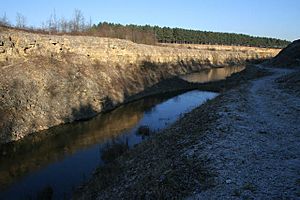Sproxton Quarry facts for kids
| Site of Special Scientific Interest | |
 |
|
| Area of Search | Leicestershire |
|---|---|
| Interest | Geological |
| Area | 5.4 hectares (13 acres) |
| Notification | 1986 |
| Location map | Magic Map |
Sproxton Quarry is a special place in Leicestershire, England. It covers about 5.4 hectares (13 acres) of land. This quarry is known as a Site of Special Scientific Interest (SSSI) because of its amazing geology. It's located north-east of the village of Sproxton.
Contents
What Makes Sproxton Quarry Special?
Sproxton Quarry is a very important site for studying rocks and the Earth's history. It's a "Geological Conservation Review" site. This means it has rocks that are important for understanding how our planet changed over millions of years.
A Window into Ancient Times
The quarry acts like a window into the past. It shows us layers of rock that formed a very long time ago. These rocks are from the Middle Jurassic period. This period was about 174 to 163 million years ago!
Layers of Rock
At Sproxton Quarry, you can see several different rock layers, or "formations." These include:
- The Lincolnshire Limestone Formation: This is one of the most complete sections of this rock type anywhere. It tells us a lot about ancient seas.
- The Grantham Formation: This layer is so important that Sproxton Quarry is a "Reference Section" for it. This means scientists use the rocks here as a perfect example of what the Grantham Formation should look like.
- The Northampton Sand Formation: This layer gives clues about the environments that existed before the limestone.
Rare Fossils: Ammonites
One of the exciting things found at Sproxton Quarry are rare ammonites. Ammonites were ancient sea creatures. They had spiral shells, a bit like snails, but they were related to modern-day squids and octopuses. Finding these fossils helps scientists understand what life was like in the oceans millions of years ago.
Why Protect Sproxton Quarry?
Sproxton Quarry was officially made a Site of Special Scientific Interest in 1986. This protection helps make sure that these important rock layers and fossils are preserved. Scientists and students can continue to study them. It helps us learn more about Earth's long and fascinating history.

